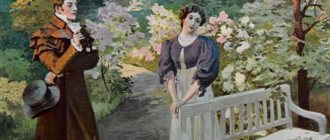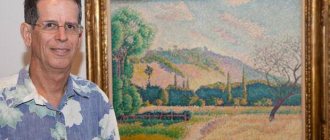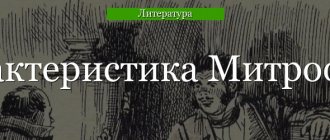The meaning of the title of Calderon's play: life is a dream
"LIFE IS A DREAM." The meaning of the title of Calderon's drama
It turned out to be elementary to reconcile these two positions, as soon as one declared the world an illusion. The greatness of man is illusory, but his dependence on the deity is also illusory. Of course, Calderon himself, a devout Catholic, would never agree that this “happened” in his best play. However, let’s look at it and see for ourselves.
The play begins with Segismundo, the prince, imprisoned since birth by his father in a specially built tower, complaining and indignant, turning to the sky. Not knowing his true “sin” (the ominous signs that foreshadowed his birth), he still admits that he was punished fairly:
Obviously, these concepts were instilled in the unfortunate man by his teacher Clotaldo, who regaled the prisoner with religious dogmas about the original sinfulness of man. Having adopted the Catholic faith, Segismundo is dissatisfied only with the fact that he alone pays for the common “sin of birth.” Later, the prince becomes indifferent to this “injustice” when he realizes that “life is a dream.”
A dream can be bad, it can be good, but in any case it is an illusion. Therefore, there is no point in complaining about your fate.
He comes to this thought after he was forgiven, called to court, committed several cruel and immoral acts there and, rejected, returned to the original state of a prisoner. We see in this a peculiar interpretation of the religious postulate about the immortality of the soul, which can live and sin (in other words, sleep), but upon death (awakening) it will return to the other world. Since Segismundo did not die, that is, did not “wake up” completely, he understands his life in prison as a dream, and his short stay in freedom, accordingly, as a dream within a dream. So, in the language of the priest, in this vale everything is perishable: crime, retribution, sadness, and joy:
Calderon n life is a dream analysis
8. Calderon’s drama “Life is a Dream”
The most striking dramatic baroque art of Calderon, by all accounts, is manifested in the drama “Life is a Dream” (1635) - “a key drama not only for Calderon’s work, but for all Baroque art.” “Life is a Dream” is a multi-issue drama,
This must be kept in mind when getting acquainted with its interpretations in Russian literary criticism. In some sources, there is an obvious desire for historical and political specification of the plot of the work (for example, the assertion that this is a play about the education of an ideal ruler), which, as it seems, is not adequate to the poetics of Calderon the playwright. The allegorical-philosophical sound of this drama can be especially clearly felt if we compare it with “The Alcalde of Salamea” - a historical play by Calderon, based on a reworking of the drama, the authorship of which is often associated with the name of Lope de Vega. And in this case, Calderon focuses on the problem of honor, but poses and solves it on more specific national historical material.
The sources of the plot of the play are varied: there are Christian legends about Varlaam and Jehoshaphat, going back to Eastern legends about Buddha, and historical chronicles (Polish-Russian relations during the Time of Troubles are described). The historical plot has been greatly transformed. Poland was chosen as the setting, which is easily explained: Poland, like Spain, is a Catholic state. Calderon transforms the chosen plot and makes it emblematic. This play is about the lot of man on earth - in both a religious and ethical sense. The central problem is the problem of free will, which is also relevant for Protestants. Their destiny is predetermined, but Catholics are not. This collision is reflected in the drama (Basilio believes the predictions of the stars and locks Segismundo in prison).
The philosophical meaning of the play.
Before us is the story of Segismundo, who does not come to understand where is life and where is sleep, how they can be separated, the result is the same - doubt (see episode with Rosaura: Sekh.: I was the King, I owned everything, / And everything I took revenge inexorably; / I loved only one woman... / And I think that was true: / Now, everything has passed, I have forgotten everything, / And only this does not pass).
A person exists without understanding whether everything around him is reality or illusion.
Segismundo’s conclusion is that it is necessary to do good, no matter whether we are asleep or awake: “Clotaldo: What are you saying?
Segismundo: That I am only dreaming, / And that I want to do good, / Having learned that goodness is forever / Leaves its invisible mark, / Even though you did it in a dream.” Good is an ethical category: to do good - to be moral, worthy.
We are talking about understanding reality and the path of man as a path of troubles that require self-restraint and self-denial. A person must choose the position of limiting his earthly desires voluntarily: see Segismundo says: “And with a spirit less free / I need less freedom”
à gains power à loses à gains again à punishes the leader of the uprising, because he broke the law (evolves from a person who wants complete and unlimited freedom to a person who obeys the law).
There are not many characters in this play, but its action is bifocal - there are two lines of intrigue (accordingly, there is no unity of action): Rosaura (and Astolfo) and Segismundo (and his life-dream).
It is also important to note the following: Segismundo loves Rosaura, but renounces her, since he must restore her honor (let him go after Astolfo), and he, by rank, is Estreya’s husband.
The meaning of the play "Life is a Dream"
Calderon's Baroque art is most clearly evident in the drama "Life is a Dream", written in 1635. This work is key not only for the work of the writer himself, but also for all Baroque art. “Life is a Dream” is a multi-problem work. The sources for the plot of the play are varied:
- Christian legends about Jehoshaphat and Barlaam;
- Historical Chronicles;
- Eastern legends about Buddha.
The historical plot of the play is greatly transformed. The location of the work is Poland. This is easy to explain: Poland, like Spain, is a Catholic state. Calderon transforms the chosen plot, making it emblematic. The play “Life is a Dream” is a work about the lot of man on earth in an ethical and religious sense. The main problem of the work is the problem of free will, which is also relevant for Protestants. Protestants have a predetermined destiny, Catholics do not. And this collision is reflected in the play: Basilio believes the predictions and locks Segismundo in prison.
Are you an expert in this subject area? We invite you to become the author of the Directory Working Conditions
The play “Life is a Dream” is the story of Segismundo, who cannot come to an exact understanding of where life is and where sleep is, and how they can be separated. A person lives without fully understanding whether what is happening around him is reality or an illusion. Segismundo concludes that we should always do good, no matter whether we are awake or asleep. Good is an ethical category. And to do good means to be worthy and moral. Here we are talking about understanding the reality of a person and his path as a path of troubles that require self-denial and self-restraint. A person should voluntarily choose the position of limiting his earthly desires.
There are not many characters in Calderon's work, but the action of the play is bifocal. There are two lines of intrigue here, which means there is no unity of action: Rosaura (and Astolfo) and Segismundo (and his life-dream).
Segismundo loves Rosaura, but renounces her because he must restore her honor. For Calderon, it is important that a person understands the limits of his capabilities and does not succumb to the feeling that overwhelms him.
Finished works on a similar topic
Course work Opposition of external and internal freedom in the drama “Life is a Dream” by Calderon 460 ₽ Abstract Opposition of external and internal freedom in the drama “Life is a Dream” by Calderon 250 ₽ Test paper Opposition of external and internal freedom in the drama “Life is a Dream” by Calderon 240 ₽
Receive completed work or specialist advice on your educational project Find out the cost
Philosophical issues of Calderon's play “Life is a Dream”
Calderon great Spanish playwright of the Baroque style
"steadfast prince", "life is a dream", "worship of the cross"
The relationship between character and plot returns to the baroque play. The plot is based on revealing the character of the main character. Or two heroes. Man returns again to the lost world. The characters of Segismundo and Rosaur and Basilio - the king (“life is a dream”) are the main ones. The person begins to make some decisions. Which begin to disfigure his own life. In a baroque play, several parallel developing plot lines appear at once. The most baroque of all Shakespeare's plays is King Lear (Lear and Daughters, Gloucester and Sons) And all the storylines complement each other.
By 1630, shifts were taking place in Spanish drama, allowing us to talk about the transition from the Renaissance to the literary era of the 17th century.
The central phenomenon of the new literary era is the work of Calderon. Calderon's drama is extremely important for solving theoretical issues of Baroque literature.
“There has always been a lot of controversy around Calderon in criticism; you can often read: “Calderon is a singer of militant Catholicism, a mystic and reactionary,” “Calderon is a great realist who reflected the best features of the Spanish people.”
There is a suspicion that such discrepancies are caused by the inconsistency of the writer himself. After all, at the same time he creates a democratic “Salama mayor” and sacred autographs on theological topics in the spirit of the ideology of the Counter-Reformation. This is absolutely false. “Calderon is an unusually solid and even sometimes tiresomely monotonous writer in his consistency. It’s just that, from our point of view today, it is difficult to combine the defense of the rights of the lower classes and the condemnation of the peasant - “an ignoramus driven by instinct”, the formula “life is a dream” with a sincere wish - “may your life be long”; glorifying the murder of his beloved wife on the basis of mere suspicion of infidelity - with complaints about the “burdensome principle of honor”; the most fanatical “worship of the cross” - with obvious sympathy for the persecuted and defeated “non-Christians”, etc.”
If in the initial period of the formation and development of Spanish national drama the contradictions between Renaissance-democratic ideals and the reality of Spanish statehood were not yet acute, then by the time Calderon’s work developed, the picture changed dramatically.
Already in the 20-30s, most contemporaries could see the ominous signs of the final decline of the Spanish Empire. The position of Spain at that time was determined, first of all, by the acute discrepancy between growing absolutism and the deepest economic crisis, the poverty of the peasant and urban lower classes. The situation of the peasantry, who made up the overwhelming majority of the country's population, was especially difficult.
All this began to lead to the disintegration of the former, once strong moral foundations, traditions and ideas, combined with the “Catholic principle”, which ruined Spain “with its oppressive dominance over all other elements of state life”
The former Renaissance-democratic ideals, nourished by national traditions (characteristic of Lope de Vega and his closest associates), began to give way to scientific-humanistic ones, which in the sphere of artistic abstraction were more easily combined with a tragic perception of reality.
Renaissance and Baroque writers, despite the lines of continuity between them, reacted differently to the onset of reaction. The playwrights of Lope's circle either focused on the tragedy of the situation in which a person who thought humanistically or lived in accordance with the secular spirit of the recent past perished, or looked at the dark period of the crisis as something transitory in comparison with the values conquered by humanity during the Renaissance.
Baroque playwrights in Spain, formed in the conditions of the 17th century. As a new historical era, although they were influenced by the Renaissance theater, they, as a rule, followed a different path. Baroque playwrights developed a new, non-Renaissance idea of harmony - both earthly and spiritual, and as only spiritual harmony opposed to earthly disorder.
“The playwrights of the 17th century, as during the High Renaissance, depicted the triumph of heroes, but thought of it in a new way, primarily in the sphere of the spirit. The picture of the world in the minds of the Baroque poets was spiritualized. They did not submit to reaction, as the kingdom of evil and lack of spirituality, and sought to show the spiritual triumph of the heroes. Sometimes the key to this triumph was titanism and a fantastic tension of passions. Invincible spirituality could be expressed in love or religious exaltation (“Love after death” and “The Steadfast Prince” by Calderon). And in the second case, religious and philosophical inspiration in his evangelical dedication still opposed counter-Reformation political utilitarianism. In the images of the heroes of the mentioned dramas, be it the Morisco Tusani or the Catholic Fernando, the main thing was not fanaticism, but perseverance of will, trust in the indestructibility of a person’s will, providing him with internal victory over unfavorable circumstances.”
“The religious and philosophical drama of the Baroque in Spain, with its awareness of human confusion on a path full of troubles, was fundamentally different from the drama of the Renaissance, but in its humanistic anti-counter-reformationism it acted as its direct successor. Only Calderon contrasted the counter-reformation ideology of spiritual violence not with the obvious correctness of harmoniously developed, noble people full of vitality, physical and mental beauty, as with Shakespeare or Lope, but with firmness of will in defeat, a confused and searching intellect.”
The contrast between the imperfect world of today and the independence of will and mind brought Baroque drama closer to the drama of classicism. Both directions, taken from a larger historical perspective, took on the mission of defending the self-awareness of man in the 17th century. The philosophical drama of the Spanish Baroque already contained rationalistic, educational elements.
Among the philosophical and symbolic plays, his “Life is a Dream” (“La vida es sueño”) is world famous.
“The main thing to take into account when assessing Calderon is the obvious subordination of all his artistic ideas (regardless of genre) to the political and philosophical rationalism inherent in his thinking. This rationalism gave Calderon’s theater a social and philosophical topicality and colored all his work with a certain absolutist and moral-religious ideology. But at the same time, under the layer of this ideology emerges - and over time, more and more clearly - a universal human timeless principle, the true humanism of Calderon, associated with advanced Renaissance ideas, as well as with the people's democratic traditions forged by the Spanish people in the centuries-old struggle for their national liberation and for your civil rights.
Calderon was the son of his century. Together with the century, everything temporary, transient, alien to us today has disappeared in his work. What remained was what was historically promising and humanly unshakable in him - his nationality, national uniqueness and at the same time the universality of thought. That is why, according to Pushkin, Calderon, along with Shakespeare and Racine, stands “at an unattainable height” and his “works constitute the eternal subject of our studies and admiration...”.”
"Life is a dream"
Repeatedly in his various plays, Calderon approached the theme of an ideal, just monarch (he touches on it, for example, in “The Doctor of His Honor” in the person of Don Pedro the Just). Calderon directly tries to solve it in one of his most famous dramas, “Life is a Dream.” It contains, if not a program for the formation of an ideal ruler, then, in any case, an edifying picture of his self-education.
Like many other works of world literature, the drama “Life is a Dream” in the eyes of subsequent generations has far outgrown the scope of its original content.
If we put together the existing interpretations of the drama “Life is a Dream,” we will get an interesting collection of contradictory and often mutually exclusive assessments.
“For a long time it was understood only as a religious-symbolic drama, the meaning of which boils down to the theological thesis of the affirmation of free will and the interpretation of life as a dream, a grandiose comedy, where people play only the stage role assigned to them, in order to then be resurrected to the highest truth in the afterlife.” .[8] Indeed, the presence of these motifs in the play cannot be denied. For Calderon, they were characteristic throughout almost all of his work, and found their direct expression in the sacred autographs “The Great Theater of the World”, “Life is a Dream” and in a number of others. The feeling of life as a fleeting moment (“sleep”) was inherent in the Spaniards’ worldview long before Calderon. “During Calderon’s period of national decline, this feeling intensified even more, and Calderon gave it the clearest artistic and philosophical formula, extremely condensing the sorrowful confession of Cervantes made through the mouth of Don Quixote {The idea of the “Great Theater of the World” was probably suggested to Calderon by diligent reading “ Don Quixote" by Cervantes (chapter XII, part 2), where Don Quixote develops to Sancho the idea that life is the same comedy, and that death equalizes everyone. And Sancho, calling this comparison “excellent,” reinforces it with a similar comparison of life to a game of chess.”
Researcher N.I. Balashov even traces the Russian theme in this drama: “The Russian-Polish plot, which had a special specific content in Spain after the famous drama by Lope de Vega “New Deeds of the Grand Duke of Moscow” (1606), also contrasts with the idea of “life is a dream.” ). With the abstract theme of “vanity of vanities,” “Life is a Dream” rumbles with echoes of Lope’s drama. Here there is both the victory of the rebellious people, and the calling of an imprisoned or exiled prince, overthrowing a tyrant (an echo of the data about Boris Godunov), removing a foreign prince (Vladislav).”
And yet, all these interpretations of the play are inextricably linked with the theme of the ideal ruler.
Life is a dream
I think everyone more or less remembers Calderon. This ticket is a two-page compilation of materials for the colloquium and a brief retelling of the drama.
Calderon's drama "Life is a Dream", published in 1636
., is perhaps Calderon’s most mysterious and profound drama.
The idea of transience, the short duration of human life
, which gave rise to the metaphorical likening of it to sleep, is one of the most ancient.
Baroque thinkers and artists were especially focused on the problem of the frailty and illusory nature of earthly existence, contrasting them with the eternity and immortality of the spirit.
The important drama “Life is a Dream” can be







